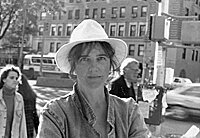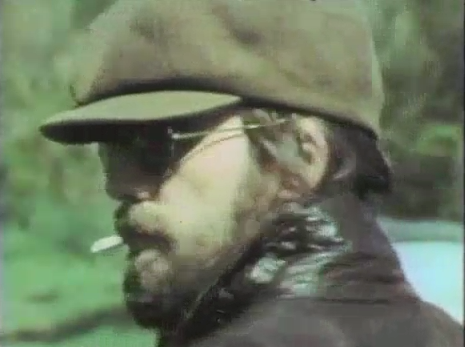
Sheldon Renan made the fifteen minute educational short, Basic Film Terms: A Visual Dictionary, as a follow up to his 1967 book An Introduction to the American Underground Film: A Unique, Fully Illustrated Handbook To The Art Of Underground Film And Their Makers.
I believe Basic Film Terms is a lost film.
(Late breaking development – an eagle eyed reader found some copies! )
(Even later breaking development – a resourceful reader found copies for sale, see comments below.)
I hereby claim it as an Oregon film on the basis of the contribution of writer-director Sheldon Renan.
Tags: Sheldon Renan
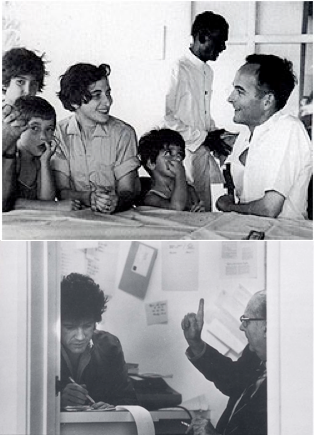
James Ivory listens to Ruth Prawer Jhabvala, above/James Blue listens to Robert Rossellini, below.
Two Oscar nominated Oregonians share the same first name. To help readers keep them apart, Oregon Movies, A to Z has compiled a handy checklist of distinguishing characteristics.
1. James Ivory was born in 1928 in Berkeley. James Blue was born in 1930 in Tulsa.
2. Ivory grew up in Klamath Falls. Blue grew up in Portland.
3. Ivory studied architecture and fine arts. Blue studied theater. Both at University of Oregon.
4. Ivory graduated from film school at USC in 1957. Blue graduated from film school at L’IDHEC in Paris in 1958.
5. Both men served in the military between undergraduate school and film school.
6. Ivory made his first feature, The Householder, in India in 1963. Blue made his first feature, The Olive Trees Of Justice, in Algiers in 1962.
7. Ivory received Oscar nominations in 1987, 1993 and 1994. He was nominated for a Palme d’Or at Cannes in 1979, 1981, 1983, 1992, 1995 and 2000. Blue beat him to this particular punch. He was Oscar nominated in 1969. He won the Critic’s Prize at Cannes in 1962.
8. More support for the hypothesis that all Oregonians are secretly French? I would say so, since four of Ivory’s films were made in France, while Blue went to film school in Paris, and his breakthrough film was in French.
9. Both men became New Yorkers. Ivory lives in New York City. James Blue lived in Buffalo, where he taught at SUNY. He died in 1980.
Tags: James Blue·James Ivory·Robert Rossellini·Ruth Prawer Jhabvala
October 18th, 2012 by Anne Richardson · News, Scorecard series
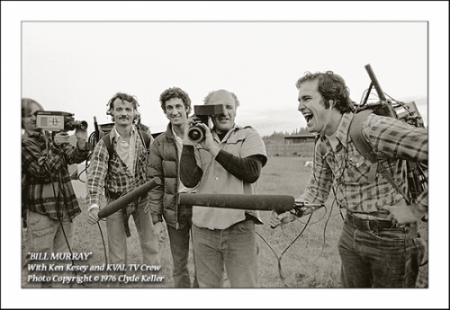
It has been quite a year for Oregon film history buffs!
Oregon used to confine its film history love to an annual celebration of The Goonies in Astoria.
But in the past year……
Katherine Wilson made Animal House of Blues (2012)
Allison Elwood & Alex Gibney made Magic Trip: Ken Kesey’s Search for a Kool Place (2011)
Alexia Anastasio made Adventures In Plymptoons: A documentary on the art and animation of Bill Plympton (2011)
Umatilla County Historical Society screened Nicholas Ray’s The Lusty Men (1952)
Deschutes County Historical Society screened Jacques Tourneur’s Canyon Passage (1946)
Clinton Street Theater screened Don Zavin’s Fast Break (1977)
Oregon Cartoon Institute screened Lew Cook’s The Little Baker (c. 1925)
Brian McWhorter composed and performed a new score for Ed’s Coed (1929)
John Paul plans to tour, conducting his original chamber orchestra score for F. W. Murnau’s City Girl (1930)
Matt McCormick re-issued the Peripheral Produce AUTO-CINEMATIC Video Mix Tape (1996) on DVD
Miranda July saluted her Peripheral Produce days with a Portland-centric screening at the Hollywood
David Walker lectured on Portland’s B Movies
Oregon Cartoon Institute brought Robert Johnston to lecture on Mel Blanc’s Portland
Matt Love wrote Sometimes A Great Movie
Dan Fiebiger wrote a history of Oregon filmmaker Tom Shaw
Bill Plympton wrote Independently Animated: Bill Plympton: The Life and Art of the King of the Indies
Anne Richardson presented Oregon Goes To The Oscars at Oregon Historical Society
Ken Nolley hosted a One Flew Over The Cuckoo’s Nest (1975) retrospective in Salem
Northwest Film Center hosted mini-retrospectives of Will Vinton, Joanna Priestley, Chel White, Lawrence Johnson, Kelley Baker, Ron Finne (with Jim Blashfield upcoming ) at the Whitsell Auditorium
Anne Richardson introduced the Dill Pickle Club’s Portland film lecture series with David Walker, David Cress, Walt Curtis, Shawn Levy, Jim Blashfield, Brooke Jacobson, Matt McCormick, Joanna Priestley, Joan Gratz, Rose Bond, Tom Robinson, Tom Chamberlin, Dennis Nyback.
Michele Kribs secured National Film Preservation Board protection for The Boy Mayor (1914)
Mary Erickson’s University of Oregon dissertation on independent filmmaking in the Pacific Northwest went online
Heather Petrocelli completed her masters thesis about the Center For The Moving Image at PSU
Lucy Burningham wrote about Oregon film history in the Bend based magazine 1859
Stan Hall wrote about Oregon film history in OMPA’s annual directory
And tomorrow, Portland Monthly’s November 2012 issue hits the stands with an article by yours truly, Anne Richardson, about Portland’s history of independent filmmaking.
SCORECARD:
Number of public lectures: 15
Number of retrospectives: 9
Number of public screenings of historic films: 4
Number of films permanently protected by the Library of Congress: 1
Number of new films (about Oregon film history): 3
Number of new books (about Oregon film history): 2
Number of new scores to silent films: 2
Number of articles (about Oregon film history): 3
Number of academic papers: 2
Tags: Alex Gibney·Alexia Anastasio·Allison Elwood·Anne Richardson·Bill Plympton·Brian McWhorter·Brooke Jacobson·Chel White·Dan Fiebiger·David Cress·David Walker·Dennis Nyback·Don Zavin·F. W. Murnau·Heather Petrocelli·Jacques Tourneur·Jim Blashfield·Joan Gratz·Joanna Priestley·John Paul·Katherine Wilson·Kelley Baker·Ken Kesey·Ken Nolley·Lawrence Johnson·Lew Cook·Lucy Burningham·Mary Erickson·Matt Love·Matt McCormick·Michele Kribs·Miranda July·Nicholas Ray·Robert Johnston·Ron Finne·Rose Bond·Shawn Levy·Stan Hall·Tom Chamberlin·Tom Robinson·Tom Shaw·walt curtis·Will Vinton
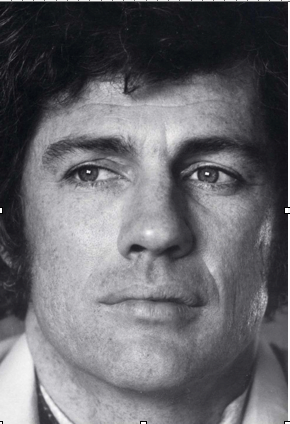
When I began exploring Oregon film history, I knew I would run across surprises. I never expected to run across a filmmaker as accomplished, and as forgotten, as James Blue.
James Blue (1930-1980) grew up in Portland. He studied speech and theater at University of Oregon, graduating in 1953. After some years of military service, he entered film school in Paris where he was influenced by Jean Rouch. Although he first distinguished himself by winning the Critics Prize at Cannes for The Olive Trees Of Justice, a feature length narrative film, he spent the rest of his life making socially engaged documentaries.
Blue was a man of firsts. First Oregon director to go to Cannes, and the first to receive an Oscar nomination. First person ever to receive Ford Foundation funding for a film project. He helped start the Center for Advanced Film Studies at American Film Institute. The documentary programs at Rice University and at the Center for Media Study in Buffalo were both established by him. He served on the 1970- 1972 NEA funding panel which launched the first network of regional film centers, as proposed by Sheldon Renan. Northwest Film Center is the result of that NEA initiative.
Two Oregonians, James Blue and Sheldon Renan, on that panel!
The reason you haven’t heard of James Blue, or seen his films, is that his films have no distributor. They are not digitized. I am not sure even SUNY Buffalo, the school where he was teaching at the time of his death, can offer access to his films.
Here’s the crash course on Blue:
His IMDB page.
An interview with one of his students
A booklet compiled to accompany a retrospective of his films.
I am still trying to make sense of this new-to-me filmmaker. James Blue never returned to live/teach/work in Oregon. He is buried in Willamette Cemetery.
Tags: James Blue·Jean Rouch·Sheldon Renan
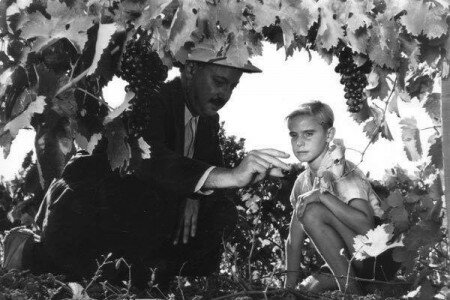
The first person to tell me about Oregon filmmaker James Blue was James Ivory.
Then Penny Allen told me that James Blue was the first Oregonian to take a film to Cannes. Blue was awarded the Critics Prize at Cannes in 1962 for his first feature length film, The Olive Trees Of Justice.
I don’t know much about Blue! He grew up in Portland and graduated from University of Oregon in 1953.
Richard Engeman did a little sleuthing:
The Oregonian reported on February 1, 1953, that James Blue was starring in “Death of a Salesman” at U. of O, where he was a senior in speech. Earlier, on October 14, 1951, he was noted as the chief carpenter for a U. of O. production of “The Madwoman of Chaillot. He also won the Oregon State Broadcasters outstanding performance award, give at the U. of O. May 14, 1953 (Oregonian, May 15). There are a number of Oregonian pieces about, or mentioning him, 1962-1980. He’s buried in Willamette National Cemetery.
The Olive Trees Of Justice, Blue’s only narrative film, was based on the novel of the same name by Algerian novelist Jean Pelegri. It was shot in Algiers, with Pelegri playing a leading role in a cast of non-professional actors. The score is by Maurice Jarre.
Here’s a description from TCM.
Jean, a young Frenchman born and reared in Algiers, returns to his native land from Paris to be with his dying father. It is during the Algerian war of independence, and as Jean sits at his father’s bedside, he recalls his happy childhood in the family vineyards, where he played with French and Arab friends. Later he walks through the strife-torn Algerian streets and feels the terrible presence of war. One day his father dies peacefully in his sleep, and relatives and friends, both French and Arab, come to pay their respects. Jean has a long discussion with an Arab friend and attempts to explain why he must return to the peaceful life he has made for himself in Paris. After his father’s funeral Jean sees his normally chauvinistic aunt hasten to help an Arab boy who has been struck by a passing truck. Moved by this genuine expression of human concern regardless of nationality, Jean decides to remain in Algeria.
James Blue was born in 1930 in Tulsa, Oklahoma. He arrived with his family in Portland in 1942. He was nominated for an Oscar in 1969. He died in 1980.
I hereby claim The Olive Trees Of Justice as an Oregon film, on the basis of James Blue’s contribution as director.
Tags: James Blue·Jean Pelegri·Maurice Jarre·Penny Allen
May 29th, 2012 by Anne Richardson · News

Walt Curtis and Matt Love celebrate Matt’s new book SOMETIMES A GREAT MOVIE …..Photo credit: Paige Tashner
Last weekend, as if to keep an invisible, necessary balance in Portland’s cultural eco system, we celebrated director Bill Plympton at the Bagdad, writer Ken Kesey at the Hollywood, and cartoonist Joe Sacco at Mercy Corps Action Center. Never have I seen such swift response to criticism in my life! Portland seems to have taken seriously my request for more ancestor worship, in the arts department.
I take entire responsibility for this surge of civic pride.
I use the word surge advisedly. Greg Hamilton reported 150 Ken Kesey/Matt Love fans were turned away from Saturday night’s screening of SOMETIMES A GREAT NOTION, held to celebrate the publication of Matt Love’s Sometimes A Great Movie.
Hey! Here’s a new niche for The Hollywood Theatre to occupy: film experiences for people who love being surrounded by other people.
Hundreds and hundreds of other people.
Time to restore the balcony seating, what say, Doug Whyte?
How about asking an architect to invent a flexible wall system so the second floor can either serve as two screening rooms (as it is now), or be opened up, as needed, to temporarily reassume its original identity as a balcony.
Back to this extraordinary weekend…..
Balancing out all this ultra regional genius, and ensuring that we don’t collapse upon ourselves in self regard, Hannah Piper Burns and Ben Popp scheduled Portland’s first Experimental Film Festival. International in scope, the five day festival included work by founding Oregon avant garde scenesters Jim Blashfield and Vanessa Renwick. Matt McCormick, whose own Peripheral Produce Festival helped launch the turbo charged indie energy which swirled all over the Rose City this weekend, gallantly used his time in front of an EFF audience to show work by other filmmakers, not his own.
In a similarly large hearted gesture, S. W Conser arranged a party at Jack London Bar specifically so that boundary defying artist John Frame could see rare stop motion animation from Dennis Nyback’s equally boundary defying collection.
So concludes the weekend wherein Portland’s major export was pure authenticity. The weekend gave every appearance of a well coordinated festival of Oregon arts – yet it just happened spontaneously. Each individual arts organization toiled in darkness for weeks/months of planning, emerging with miraculous simultaneity into the spring sunshine.
And its not over yet.
Tonight Brian Kellow, author of Pauline Kael: A Life In The Dark, speaks at NWFC. Born and raised in Tillamook, Oregon, educated by OSU, Kellow now lives in New York, edits Opera News, and writes the occasional book. If you lived in New York, you would understand what this means: Mr. Kellow is the winner of the Game of Life.
Speaking of NWFC, indie legend Jon Jost, familiar to readers of Oregon Movies, A to Z as a well qualified lillypadder, having made his first film in Cottage Grove about a zillion years ago, will introduce the May 31 screening of Last Chants For a Slow Dance ( 1977), one of his most highly regarded films.
I am aware not everything happens in Portland! This weekend, just up the river, writer-producer-actress Carrie Brownstein performed with Wild Flag at Sasquatch. But some important stuff does happen here. Or at least will, come next September. It only took 50 hours on Kickstarter for Andy Baio’s Portland-centric XOXO Festival to sell out.
That’s pre-selling tickets at $400 a pop!
As Portlander Curtis Salgado, no slouch himself when it comes to authenticity, recently opined: “People came from blocks around/Just to hear his righteous sound”
Given the turnouts at the multiple arts events in Portland this weekend, I have to say …..seems to be true!
Here are the organizations behind the above described synergy:
Clinton Street Theater
The Dill Pickle Club
Experimental Film Festival
Hollywood Theatre
Jack London Bar
KBOO’s Word & Pictures
McMenamins/Bagdad Theatre
Mercy Corps Action Center
Oregon Cartoon Institute
Oregon Media Producers Association
Portland Art Museum
Northwest Film Center
Sasquatch
XOXO Festival
Tags: Andy Baio·Ben Popp·Bill Plympton·Brian Kellow·Carrie Brownstein·Curtis Salgado·Dennis Nyback·Doug Whyte·Greg Hamilton·Hannah Piper Burns·Jim Blashfield·Joe Sacco·John Frame·Jon Jost·Ken Kesey·Matt Love·Matt McCormick·Paige Tashner·Pauline Kael·S. W. Conser·Vanessa Renwick·walt curtis
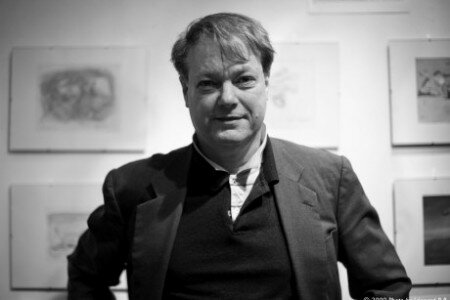
I first met Bill Plympton at the Oregon Book Awards. He arrived at the Scottish Rites Temple with Walt Curtis, who was wearing a tie and jacket several sizes too large, his hair in its signature white aureole around his poet’s brow. Walt was with Marjorie, his long time friend and familiar. They entered single file, circling around the back of the room.
I was at the refreshments table, eating miniature cream puffs. Bill joined me, and we began discussing the evening’s awards, our shared New York City citizenship, and fact that I had been to a party he gave in New York some years before, although neither he nor I remembered anything about it. We stood there talking these things over, and I remember realizing that I was thinking of things to say so that I could continue eating cream puffs, and furthermore, that he was doing the same thing. That was my bonding experience with Bill Plympton. Eating cream puffs, waiting for Ken Kesey to receive a lifetime achievement award, and silently plotting how to meet Walt Curtis.
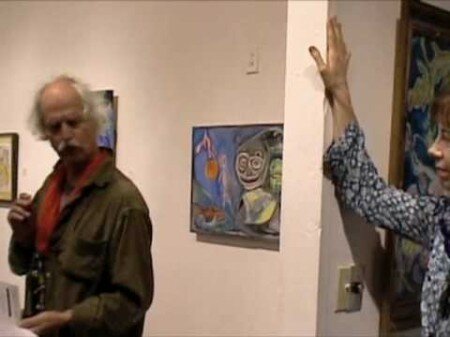
The next time I met Bill Plympton, I was with Walt Curtis, taking him around New York. Walt had come to give a live introduction to Peckerneck Poet, the feature length documentary Bill had made about him. Bill didn’t come to the screening, so Walt and I visited him the following day, on the roof of the building which held his studio in Chelsea. We sat around in the dusk of the city, and talked. I had picked Walt up at Bill’s apartment. It was spare and featureless, the home of a man who was never home.
The third time I met Bill Plympton was at his annual summer gathering on the banks of the Clackamas River, on his parents’ property. He was demonstrating to a young child how to use a water cannon which shot great burst of water. His mother had waved us down to the path to the river, telling us to look out for the llama. Bill was everywhere, a solicitous host. There was no hostess, although there were several women in bathing suits who were jostling for position next to Bill.

The fourth time I met Bill Plympton was at a party in SE Portland. I had come specifically to invite him to speak at a film festival the following spring. It sounds as if I only go to parties to proposition people, and that’s pretty much true. So be forewarned, when you see me at a party. Bill listened, and said yes. From that moment on, I no longer met Bill as a distant friend of a friend. By asking Bill to speak at the festival, I had invited him to join me in some serious work. This is the way to Bill’s heart, to be hard at work on something. Bill understands work. He works all the time. How else can he draw all the tens of thousands of frames he needs to complete a feature length film? Bill lives in his work. It vivifies him. Once he and I were working together on something, all the other pretexts, the cream puffs, the water cannons, the Manhattan rooftops, fell away. We achieved perfect communion in the shared vision of work. So I have been privileged to collaborate with Bill. This is what it feels like to work with an Academy Award nominated director.
It feels like this:
Bill is practical.
Bill is concise.
Bill is effective.
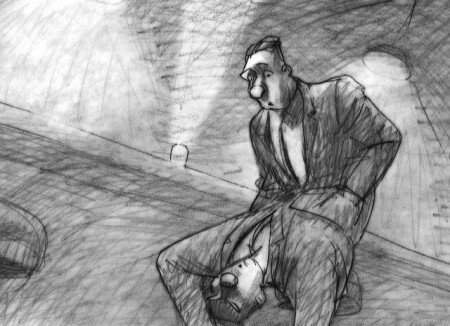
Here’s the things he is not: he is not neurotic, not self aggrandizing, not long suffering, not wasteful, and not filled with false modesty.
He is extremely focused.
Bill showed me something I hadn’t known before. It is possible to carry on an extended, productive conversation with an extremely busy person IF you are willing to grab it during interstitial moments. In the months Dennis and I planned the festival Bill was coming to, he gave us more input than I dreamed he would have time to give. Some of it came over the phone from New York. Some of it came during brief moments we could grab while he was in transit from one place to another. We talked during a ride he needed to the airport, or between courses during a dinner he was having with friends at Jake’s, or between speaking gigs at the Ashland Independent Film Festival. He wasn’t multitasking, he was eliminating empty spots in his day. Why do nothing, when he could consult with us and improve our film festival? So that’s what he did.
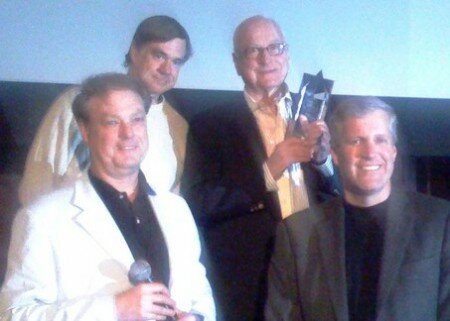
At the festival, Gus Van Sant tapped Bill to present James Ivory with the Oregon Sesquicentennial Lifetime Achievement Award. I knew Bill was jet lagged, so tired he could barely stay awake, so I was surprised at the end when he asked James Ivory the final question of the evening: what is your dream project? what film would you most like to make?
I never knew that film directors wondered these things about each other.
James Ivory said the film he next wanted to make was a love story set in Peru. He told us “I want people to clutch at their hearts at the beauty I’ve made.” After the festival, perhaps not coincidentally, Gus’ next film was a love story. Bill’s next film, which he is still drawing, is a love story
All of Bill’s films may well be love stories. The stories are getting deeper, the love more mysterious and spiritual. It is as if Bill, having grown accustomed to sharing his innermost sexual fantasies in vivid, comic detail, has become so divested of inhibition that there is nothing to stop him from sharing his deepest worries, his sorrows, his pain and his soul. In Idiots and Angels, the story is so large, so expansive and so filled with grief, that it requires three endings.

Since the festival, Bill has written two books, toured the world with an award winning short, adopted an entirely new identity as a film preservationist, started an animation school, and transformed himself into a married man. And all the while, he continues to draw his next feature. I won’t say “I don’t see how he does this!” I do see how he does this. He takes everything he does very seriously. He likes to work. He likes the people he works with, he is a clear communicator, and he doesn’t waste time. Bill’s formula for filmmaking success, repeated to audiences around the world, is “short, fast and cheap.”
Excuse me, Bill, but what an act of artistic camouflage! Some of your films may meet these three criteria, but your entire career defies that description. I write this appreciation as a salute to that fact.
====================================================
Photo credit: Shawn Levy took the photo of James Ivory, Gus Van Sant, Bill Plympton and Mike Rich on May 1, 2009 at Marylhurst University’s Oregon Sesquicentennial Film Festival.
Tags: Bill Plympton·Dennis Nyback·Gus Van Sant·James Ivory·Ken Kesey·Shawn Levy·walt curtis·Winsor McCay
“Perhaps it is the climate, and then again, perhaps it is the illustrious example of the late Homer Davenport, but climate or whatever, the soil of Oregon seems to be prolific of cartoonists.”
The Oregonian, in 1914.
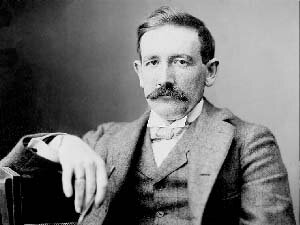
1. Homer Calvin Davenport (1867 – 1912) was the son of a well educated, politically progressive Oregon Trail pioneer. Brought up on a farm in Silverton, Homer became, after a series of vocational false starts, the most highly paid newspaper cartoonist in the world. His political cartoons, drawn for Hearst newspapers, were so influential legislation was introduced in New York State to outlaw them. As one of the country’s first media superstars, Homer Davenport was wealthy, powerful, well connected, and homesick. He dreamed of leaving New Jersey to return to Oregon, but his wife would not hear of it. Born in the Waldo Hills. Self taught.
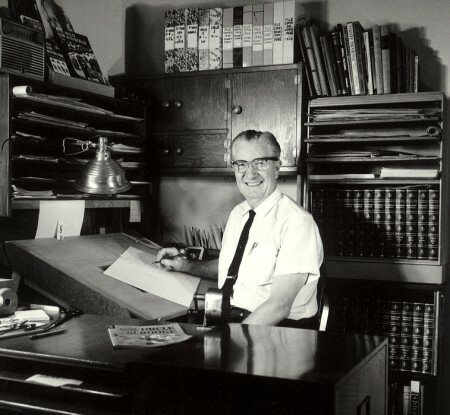
2. Carl Barks (1901 – 2000) was the creator of Uncle Scrooge McDuck, and the writer-artist auteur behind Disney’s Duckville comic books. Revered for his story sense and superior draftsmanship, he has been claimed as an inspiration by figures as diverse as R. Crumb and Steven Spielberg. Barks was chosen as one of three figures to inaugurate the Will Eisner Comic Book Hall Of Fame in 1987. Born and raised on an isolated ranch in Merrill. Self taught.
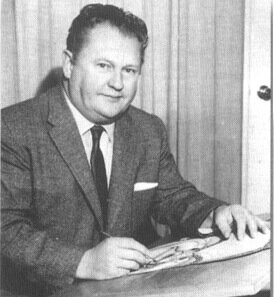
3. Basil Wolverton (1909 – 1978) was the first Pacific Northwest cartoonist to conduct his entire career by mail, without leaving the Portland area. Enormously influential, his innovative “spaghetti and meatballs” style challenged the boundaries of good taste and changed the face of American comics. Robert Crumb’s recently published Book Of Genesis is a tribute to Wolverton, while Jerry De Fuccio of Mad Magazine thought the comics industry version of the Oscar should be called “The Basil”. Born in Central Point. Self taught.

4. Born in Oregon City in 1946, Bill Plympton worked as an illustrator and syndicated cartoonist in New York for 15 years before switching to animation. His work has appeared in the New York Times, Vogue, Vanity Fair, Variety, Rolling Stone, Glamour and National Lampoon. Bill Plympton is the only filmmaker alive who hand draws feature length films. He has drawn six of them, and is a two time Oscar nominee. Matt Groening, for one, believes “Bill Plympton is God”.
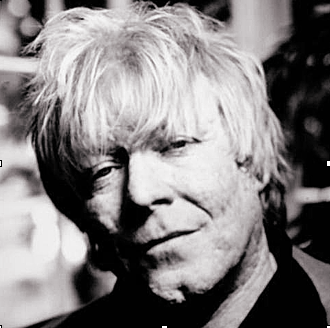
5. Born in Portland in 1951, John Callahan began cartooning in the late 70‘s, after a car accident confined him to a wheelchair. He brought a portfolio of cartoons to a PSU class taught by Bill Plympton, and the rest is history. His syndicated cartoons appeared in the San Francisco Chronicle, the New York Daily News, The London Observer, the Los Angles Times, the Chicago Tribune, Harpers, the Utne Reader, Willamette Week and 50 other publications. Two animated television series, Quads and Pelswick, were based on his work. He died in 2010, of complications related to his quadriplegia.

6. Born in Portland in 1954, Matt Groening is the creative force behind the longest running scripted show in television history. The Simpsons has won 27 Emmy Awards, 30 Annie Awards and a Peabody Award. He is the third Oregonian to have a star on Hollywood Boulevard, after Jane Powell and Mel Blanc. Throughout all this, Groening has remained active as a cartoonist, publishing his syndicated strip, Life In Hell, every week since 1977. He cheerfully admits “Cartooning is for people who can’t quite draw and can’t quite write. You combine the two half-talents and come up with a career.”
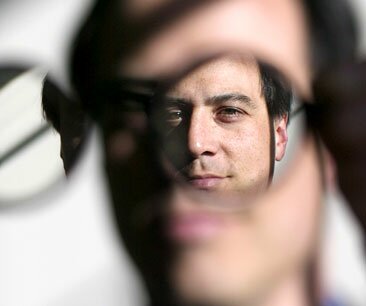
7. Born in Portland in 1959, David Chelsea was selling cartoons before he was in high school. His work appears in hundreds of publications including the New York Times (where he illustrated the Modern Love column), The Wall Street Journal, The New York Press, Seattle Weekly, Chicago Tribune, Reader’s Digest, Boston Phoenix and Portland Monthly. For years, the New York Observer carried David’s celebrity caricatures on the front page.
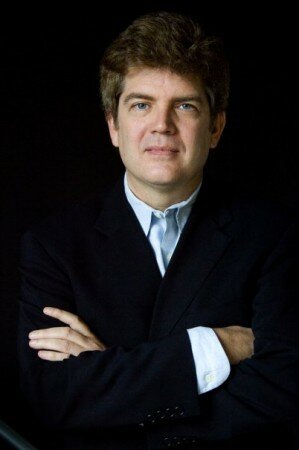
8. Born in 1960 in St. Paul, Minnesota, Jack Ohman moved to Portland in 1983 to begin working as a cartoonist for The Oregonian. His cartoons appear in hundreds of newspapers including The New York Times, The Washington Post, The Philadelphia Inquirer, The Boston Globe, The Chicago Tribune, The Seattle Times, and The Baltimore Sun. He is the author of ten books, and winner of numerous awards, including the 2009 Robert F. Kennedy Journalism Award, the 2010 Society of Professional Journalists Award and the 2012 Scripps Howard Journalism Award.

9. Born in Malta in 1960, Joe Sacco moved with his family to Beaverton in time to attend Sunset High School. Graduating with a journalism degree from University of Oregon, he found his true calling when he began using the comic strip format to cover the war in Palestine. Internationally renowned, he is the winner of the 1996 American Book Award, 2001 Guggenheim Fellowship, and the 2001 Eisner Award.
10. Two emerging Oregon cartoonists share the #10 spot.

Shannon Wheeler moved to Portland in 2010. You’ve seen his cartoons in the New Yorker.
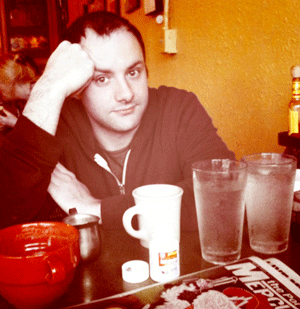
Matt Bors received the 2012 Herblock Prize, the first alternative editorial cartoonist to win that honor.
Learn more about Homer Davenport, the first in this illustrious string of Oregon cartooning geniuses, in this month’s issue of the magazine 1859. Or attend your choice of three Homer Davenport events taking place in Portland this month:
Saturday, April 21, 2:35 – 3:45 PM
“Occupy Davenport: Cartoons for the 99%”, panel at Bus Project’s Rebooting Democracy @ Backspace Cafe
Tuesday, April 24, 7:30 PM @ Jack London Bar
“Stumptown Stories: Homer Davenport Covers Dempsey vs Fitzsimmons Prizefight” Speakers: Gus Frederick & Gordon Munro
Saturday, April 28, 11:00 – 11:45 AM
Homer Davenport Presentation & Panel Discussion @ Stumptown Comics Fest
All three events are the brainchildren of Gus Frederick, lead organizer of the Davenport Project. Frederick was inspired by last summer’s Mel Blanc Project, a series of public history/arts education events presented by Oregon Cartoon Institute.
========================================
This post brought to you by Oregon Cartoon Institute, a colloquium of individuals and organizations interested in raising awareness of Oregon’s rich animation and cartooning history.
Tags: Basil Wolverton·Bill Plympton·Carl Barks·David Chelsea·Gus Frederick·Homer Davenport·Jack Ohman·Jane Powell·Jerry De Fuccio·Joe Sacco·John Callahan·Kenny Scharf·Matt Bors·Matt Groening·Mel Blanc·Monte Wolverton·Oregon Cartoon Institute·Robert Crumb·Shannon Wheeler·Steven Spielberg·Will Eisner
April 7th, 2012 by Anne Richardson · 1960's, Oregon writer
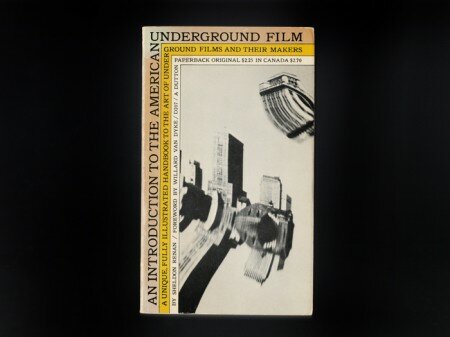
Everyone read An Introduction to the American Underground Film: A Unique, Fully Illustrated Handbook To The Art Of Underground Film And Their Makers when it came out in 1967. Everyone. It covers the work of Maya Deren, Kenneth Anger in Los Angeles; James Broughton, Bruce Conner in San Francisco; Harry Smith, Jonas Mekas, Andy Warhol and the Kuchar Brothers in New York, among others.
Its author? Oregonian Sheldon Renan.
Sheldon told me that when he was in high school, there were only three hip people in all Oregon City. He was one, and Walt Curtis was the other. I am dying to know who the third was. Sheldon went off to Yale, Walt to PSU. Both men made foundational contributions to independent filmmaking in Oregon.
Walt did this by writing Mala Noche, the novella on which Gus Van Sant based his first feature.
Sheldon did this by writing the first National Endowment for the Arts proposal for a network of regional film centers, launching the process which led to the formation of the Northwest Film Center.
Subtract Gus Van Sant and the NWFC from Portland’s current film scene, and you can see how large the contributions of these two Oregon City beatniks were.
Was Sheldon the first person to write a guide to American underground filmmaking? I believe he was.
Sheldon has returned to Oregon and continues to be hopelessly hip. The simplicity of his insight, “Devices can be small on the outside, but large on the inside”, provides the clinching argument for cyber anthropologist Amber Case’s description of Liquid Modernity.
Tags: Amber Case·Andy Warhol·Bruce Conner·George Kuchar·Harry Smith·James Broughton·Jonas Mekas·Kenneth Anger·Maya Deren·Mike Kuchar·P. Adams Sitney·Sheldon Renan·walt curtis

In 1921, William and Irene Finley pulled out a camera and documented their friendship with a hungry campsite visitor.
Here’s the filmmaker:
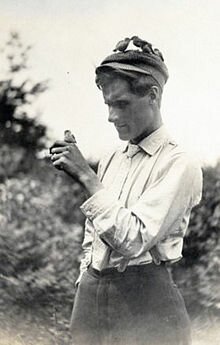
Finley was an early conservationist. Oregon’s first fish and game commission was set up in 1911, following his recommendation. You can visit William L. Finley National Wildlife Refuge, named in his honor, just south of Corvallis.
Here’s how short Oregon’s history is.
William Finley was born in Santa Clara California, on Aug. 9, 1876. That’s one month after Custer’s Last Stand. His parents, John Pettus Finley and Nancy Catherine Rucker, had traveled west by covered wagon. His uncle, William Asa Finley, was the first president of Oregon State University.
William himself was one of the first presidents of Audubon Society of Portland. Notice the birds on his head! He made this film the same year Rudolf Valentino appeared in The Sheik and Charlie Chaplin appeared in The Kid.
At the time Chumming With Chipmunks was made, all feature films were preceded by newsreels. So although William Finley’s chipmunk film did not win the international accolades which later came to Perri, an Oregon film with a similarly wild cast, it was seen by movie audiences across the country.
I hereby claim Chumming With Chipmunks as an Oregon film, based on the Oregon citizenship of the director William and camerawoman Irene.
Tags: Charlie Chaplin·George Armstrong Custer·Irene Finley·Ralph Wright·Rudolf Valentino·William Asa Finley·William L. FInley























